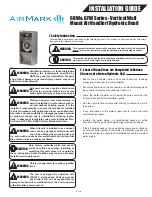
22
6.2.5.3.
Replacement loss chart
TABLE 7. Replacement loss
6.2.6. Active carbon filters
The degree of deterioration of active carbon filters is
difficult to determine since it depends on the
concentration and type of aerosol in the air to be
deodorised. In order to maintain efficient deodorisation,
TCF recommends that the filters be replaced every 30-40
days.
TABLE 8
Capacity of active carbon filters to adsorb certain
substances
6.3.
HEAT EXCHANGERS
6.3.1. Water exchanger
In order to maintain an optimum water/air heat
exchange, the following MAINTENANCE OPERATIONS
must be performed regularly on the exchangers:
- At the beginning of each operating season, remove the
air present in the exchanger circuit using the relevant air
valve.
- At the beginning of each operating season, remove dust
and deposits from the finned block. Proceed as follows:
• use a jet of compressed air in the opposite direction to
the air flow during normal unit operation
• or wash the finned block with water, non-corrosive
components and a wire brush
- Remove any deposits from the condensate and drain
trap. This operation must be repeated every month in
order to prevent flooding of the machine and the room in
which it is installed.
To avoid causing irreparable damage to the heat
exchangers, you must make sure that the primary fluid
will not risk freezing with the arrival of winter. For this
purpose TCF recommends the following steps:
- In the case of prolonged idleness of the heat exchanger
circuits, they should be completed drained
- Where an anti-freeze system based on heating elements
is provided to protect the exchanger, make sure that the
control board is constantly powered up
- On systems operating with anti—freeze, check its
efficiency and top up or replace as necessary.
ANTI-FREEZE LIQUID MUST NEVER BE INTRODUCED
INTO A CIRCUIT NOT SPECIFICALLY SIZED FOR THE
PURPOSE as it would impair pump operation and heat
exchanger efficiency.
6.3.2. Extraction of heat exchangers
Because there is frequently insufficient room for the
operator, it is not always possible to carry out the
necessary maintenance on the heat exchanger while it is
installed in the Air Treatment Unit.
In these cases the exchanger must be extracted and this
operation calls for the greatest care. To remove the
exchanger you must:
- make sure you have enough room for the removal and
temporary accommodation of the heat exchanger
- consider that an ordinary Cu/Al heat exchanger has a
mass of approximately 10 kg/m2 of frontal area per rank;
therefore, prepare supports if you think it necessary
- completely drain the heat exchanger
- remove the Unit panel covering the hydraulic
connections and the panel through which the exchanger
will be removed
- release the heat exchanger by undoing the relevant
clamps and extract it
- on completion of maintenance, restore the ideal
exchanger operating conditions.
Содержание ZAE Series
Страница 1: ...1 INSTALLATION OPERATION AND MAINTENANCE MANUAL AIR HANDLING UNITS ZAE SERIES ...
Страница 30: ...30 ...


































